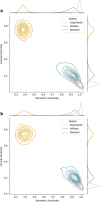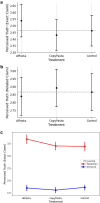The persuasive potential of AI-paraphrased information at scale
- PMID: 40697191
- PMCID: PMC12281505
- DOI: 10.1093/pnasnexus/pgaf207
The persuasive potential of AI-paraphrased information at scale
Abstract
In this article, we study how AI-paraphrased messages have the potential to amplify the persuasive impact and scale of information campaigns. Building from social and cognitive theories on repetition and information processing, we model how CopyPasta-a common repetition tactic leveraged by information campaigns-can be enhanced using large language models. We first extract CopyPasta from two prominent disinformation campaigns in the United States and use ChatGPT to paraphrase the original message to generate AIPasta. We then validate that AIPasta is lexically diverse in comparison to CopyPasta while retaining the semantics of the original message using natural language processing metrics. In a preregistered experiment comparing the persuasive potential of CopyPasta and AIPasta (N = 1,200), we find that AIPasta (but not CopyPasta) is effective at increasing perceptions of consensus in the broad false narrative of the campaign while maintaining similar levels of sharing intent with respect to Control (CopyPasta reduces such intent). Additionally, AIPasta (vs. Control) increases belief in the exact false claim of the campaign, depending on political orientation. However, across most outcomes, we find little evidence of significant persuasive differences between AIPasta and CopyPasta. Nonetheless, current state-of-the-art AI-text detectors fail to detect AIPasta, opening the door for these operations to scale successfully. As AI-enabled information operations become more prominent, we anticipate a shift from traditional CopyPasta to AIPasta, which presents significant challenges for detection and mitigation.
Keywords: cognitive heuristics; generative AI; illusory truth effect; information campaigns; persuasion.
© The Author(s) 2025. Published by Oxford University Press on behalf of National Academy of Sciences.
Figures







Similar articles
-
Short-Term Memory Impairment.2024 Jun 8. In: StatPearls [Internet]. Treasure Island (FL): StatPearls Publishing; 2025 Jan–. 2024 Jun 8. In: StatPearls [Internet]. Treasure Island (FL): StatPearls Publishing; 2025 Jan–. PMID: 31424720 Free Books & Documents.
-
Eliciting adverse effects data from participants in clinical trials.Cochrane Database Syst Rev. 2018 Jan 16;1(1):MR000039. doi: 10.1002/14651858.MR000039.pub2. Cochrane Database Syst Rev. 2018. PMID: 29372930 Free PMC article.
-
Signs and symptoms to determine if a patient presenting in primary care or hospital outpatient settings has COVID-19.Cochrane Database Syst Rev. 2022 May 20;5(5):CD013665. doi: 10.1002/14651858.CD013665.pub3. Cochrane Database Syst Rev. 2022. PMID: 35593186 Free PMC article.
-
The Black Book of Psychotropic Dosing and Monitoring.Psychopharmacol Bull. 2024 Jul 8;54(3):8-59. Psychopharmacol Bull. 2024. PMID: 38993656 Free PMC article. Review.
-
Interventions to improve antibiotic prescribing practices for hospital inpatients.Cochrane Database Syst Rev. 2013 Apr 30;(4):CD003543. doi: 10.1002/14651858.CD003543.pub3. Cochrane Database Syst Rev. 2013. Update in: Cochrane Database Syst Rev. 2017 Feb 09;2:CD003543. doi: 10.1002/14651858.CD003543.pub4. PMID: 23633313 Updated.
References
-
- Bell E. 2023. A fake news frenzy: why ChatGPT could be disastrous for truth in journalism. Guardian. 1(10):2023.
-
- Goldstein JA, et al. 2023. Generative language models and automated influence operations: emerging threats and potential mitigations, arXiv, arXiv:2301.04246, preprint: not peer reviewed. 10.48550/arXiv.2301.04246 - DOI
-
- Habgood-Coote J. 2023. Deepfakes and the epistemic apocalypse. Synthese. 201(3):103.
-
- Hsu T, Thompson SA. Disinformation researchers raise alarms about AI chatbots. In: International New York Times. 2023.
-
- World Economic Forum . 2024. The global risks report 2024. [accessed 2024 Nov 08]. https://www.weforum.org/publications/global-risks-report-2024/2024.
LinkOut - more resources
Full Text Sources
Research Materials

